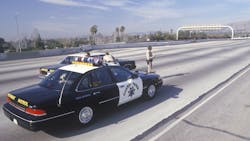When I was a rookie highway patrolman, a veteran law enforcement officer took me out roadside along an open interstate highway. "I could sit here 20 years," he said, "and never see a crash." He then drove us back to town and pulled over near a busy intersection. "Here’s where you will see crashes—where vehicles and drivers interact.”
Turning to me with a serious expression, he added, “your job is to be a gardener. There may be a few weeds out there on the interstate, but it’s the weeds here among the flowers and vegetables that are the problem. Find them and pull them out of traffic.”
See also: Lifesaving lessons from law enforcement
The “gardener” self-image probably won’t come up in conversation with a law enforcement officer. But gardening does capture an officer's thought process. Looking out at that flower bed of free-flowing traffic, what actors and actions might bring it all to an unsafe halt? Those are the weeds that require law enforcement attention.
Officers see a lot of traffic violations, but it is the flagrant ones, the ones which endanger other drivers and vehicles, that trigger law enforcement response. Cars or trucks, it doesn’t matter.
The officer will often see a vehicle making lane changes and moving a little faster than the traffic stream. That is the one to stop. Following too close is another violation that presents a greater potential for a crash and will catch an officer’s attention. When motorists drive too close together and traffic suddenly slows or stops, the trailing vehicle is going to rear-end the vehicle in front of them or suddenly swerve to avoid the crash. Pull that weed.
Aggressive, reckless, and erratic driving are always triggers for enforcement. The highway patrol manual on good gardening lists these “weeds”:
Weaving in and out of traffic.
Blocking vehicles attempting to pass or change lanes.
Using headlights or brakes to “punish” other drivers.
Speeding while in heavy traffic.
Running red lights or stop signs.
Defective equipment—headlights or taillights.
Motor carriers and truck drivers may feel that law enforcement singles them out while other seemingly unsafe operators continue down the road. And truckers would be right—commercial motor vehicles are the largest objects in the traffic stream, often like that towering weed amid the smaller plants. Trucks take longer to stop and are less maneuverable in emergencies. Due to their weight and mass, a truck-involved crash can have serious consequences—even if not caused by the trucker. For that reason, a law enforcement officer will often pull a trucker over to advise a little slower speed and a little more room.
See also: Embark engineers create way for law enforcement to interact with self-driving trucks
On the other hand, law enforcement officers will watch for some truck-specific hazards. Unstable load securement or torn mud flaps can result in obstacles on the road. A truck taking a road known as a “weigh station avoidance route” will often garner full law enforcement attention. And while the speeding truck out there on the open interstate may not yet constitute a dangerous “weed,” the law enforcement officer will make sure that behavior doesn’t spread to the urban flowerbed ahead.
The careful gardener will prune and pull to ensure the best result for all plants. It’s a little tougher with moving vehicles, but that is the officer's thought process.
Steve Vaughn is vice president of field operations at PrePass Safety Alliance, the provider of PrePass weigh station bypass and toll-payment and management services. Vaughn served nearly three decades with the California Highway Patrol and is a past president of the Commercial Vehicle Safety Alliance.
About the Author
Steve Vaughn
Senior Vice President of Field Operations
Steve Vaughn is senior vice president of field operations at PrePass Safety Alliance, the provider of PrePass weigh station bypass and electronic toll-payment and management services. Vaughn served nearly three decades with the California Highway Patrol and is a past president of the Commercial Vehicle Safety Alliance.
